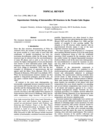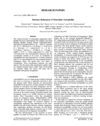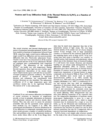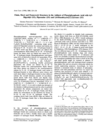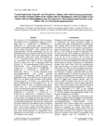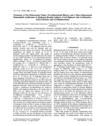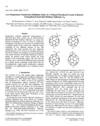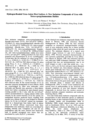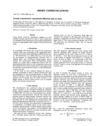issue contents
April 1998 issue

Cover illustration: Space filling representation of the hydrated anionic framework formed by trimesic acid around piles of cobalticinium cations in crystalline [(C5H5)2Co][(H3TMA)(H2TMA)].2H2O. Graphics (picture or drawing) obtained using SCHAKAL by E. Keller, University of Freiburg, Germany. Courtesy of D. Braga and F. Grepioni
topical reviews
The class of B8-type compounds (structure types NiAs, Ni2In and to some extent MnP and Co2Si, and superstructures thereof) has attracted interest throughout the history of crystallography. Today, there is renewed interest in this topic from the point of view of modulated structures and structured diffuse scattering.
research papers
Download citation


Download citation


The crystal structure of monoclinic astrophyllite, whose chemical composition and crystal structure are different from astrophyllite (triclinic system), has been redetermined.
Download citation


Download citation


Using ionic radii and calculated Mulliken charge densities it is possible to predict cell parameters and atomic coordinates for members of an isostructural series. For the β-K2SO4 series, predictions agree well with experiment, except for an early structure determination of Rb2CrO4. New X-ray data give a structure in close accord with that predicted. Parameters are predicted for the, as yet, undetermined structures of Rb2MnO4 and Rb2FeO4.
Download citation


Download citation


The structure and atomic thermal motions of K2PtCl6 are studied as functions of temperature between 8 and 380 K with 11 neutron and X-ray single crystal and powder data sets.
Download citation


Download citation


Phenylphosphonic acid forms a stem-and-leaves motif in its 1:1 adduct with 4,4'-bipyridyl, where the acid-dimer motif is retained; in its 2:1 adduct with piperazine, where sheets are formed, again the acid-dimer motif is retained. The 2:1 adduct with DABCO shows retention of the acid-chain motif in a three-dimensional framework structure.
Download citation


Download citation


The 2:1 adducts formed between 4,4'-thiodiphenol or 4,4'-sulfonyldiphenol with cyclam take the form of supramolecular ladders, with chains of diphenol anions forming the uprights and [cyclamH2]2+ cations the rungs; with CH3C(C6H4OH)3, cyclam forms a three-dimensional interwoven structure without void spaces.
Download citation


Download citation


4,4'-Biphenol forms simple chains in its 1:1 adduct with 1,4-diazabicyclo[2.2.2]octane, two-dimensional sheets in its methanol-solvated 2:1 adduct with 1,2-diaminoethane and a three-dimensional diamondoid architecture in its 1:1 adduct with 1,2-diaminoethane.
Download citation


Download citation


Pseudoacids are cyclic oxoacids or lactols formed in favorable cases by intramolecular reaction of carboxylic acid and aldehyde or ketone functions. The resulting nominal C-O bonds from the former aldehydo or keto carbon differ in length by ~0.08Å, based on disparities in oxyanion leaving-group basicities.
Download citation


Download citation


Combined use of synchrotron radiation and area-detector technology allows the structure of a twinned crystal containing two isomers of the title compound to be solved.
CCDC reference: 1220758
Download citation


Download citation


The novel inclusion complex 2(n-C3H7)4N+F−.7(NH2)2CO.- 3H2O contains a channel framework built from urea ribbons that are bridged by fluoride ions, water molecules and other urea molecules. The complexes (n-C3H7)4N+Cl−.y(NH2)2CO (y = 2, 3) feature layer and channel-type urea-chloride host lattices, respectively, whereas the isomorphous compounds (n-C3H7)4N+- X−.3(NH2)2CO.H2O (X = Br, I) exhibit a channel-type host lattice built of corrugated urea layers and centrosymmetric cyclic (H2O–X−)2 units.
short communications
Virtually extinction-free 58 keV (0.214 Å) synchrotron radiation data on Al2O3 produce high-quality deformation electron density maps, which compare very well with theoretical maps.
books received
Free 



 journal menu
journal menu








